Manmohan Singh's Economic Policies
VerifiedAdded on 2020/04/15
|14
|3373
|114
AI Summary
This assignment examines the economic policies implemented during the tenure of Indian Prime Minister Manmohan Singh. It analyzes the impact of his policies on economic growth, inflation, and the provision of subsidies. The text discusses both positive aspects, such as rapid expansion of the economy, and negative challenges, including rising fuel costs and allegations of corruption within the Congress party.
Contribute Materials
Your contribution can guide someone’s learning journey. Share your
documents today.
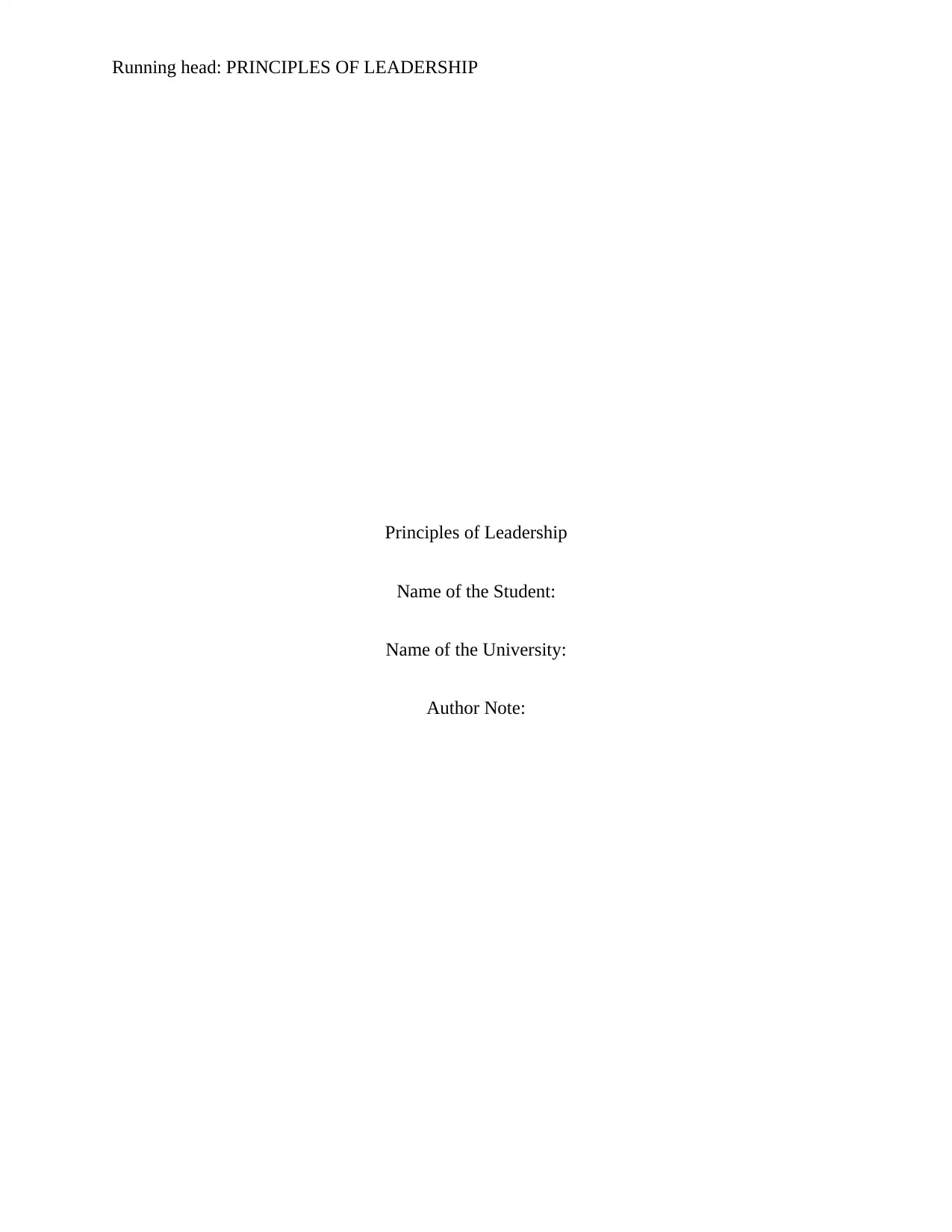
Running head: PRINCIPLES OF LEADERSHIP
Principles of Leadership
Name of the Student:
Name of the University:
Author Note:
Principles of Leadership
Name of the Student:
Name of the University:
Author Note:
Secure Best Marks with AI Grader
Need help grading? Try our AI Grader for instant feedback on your assignments.
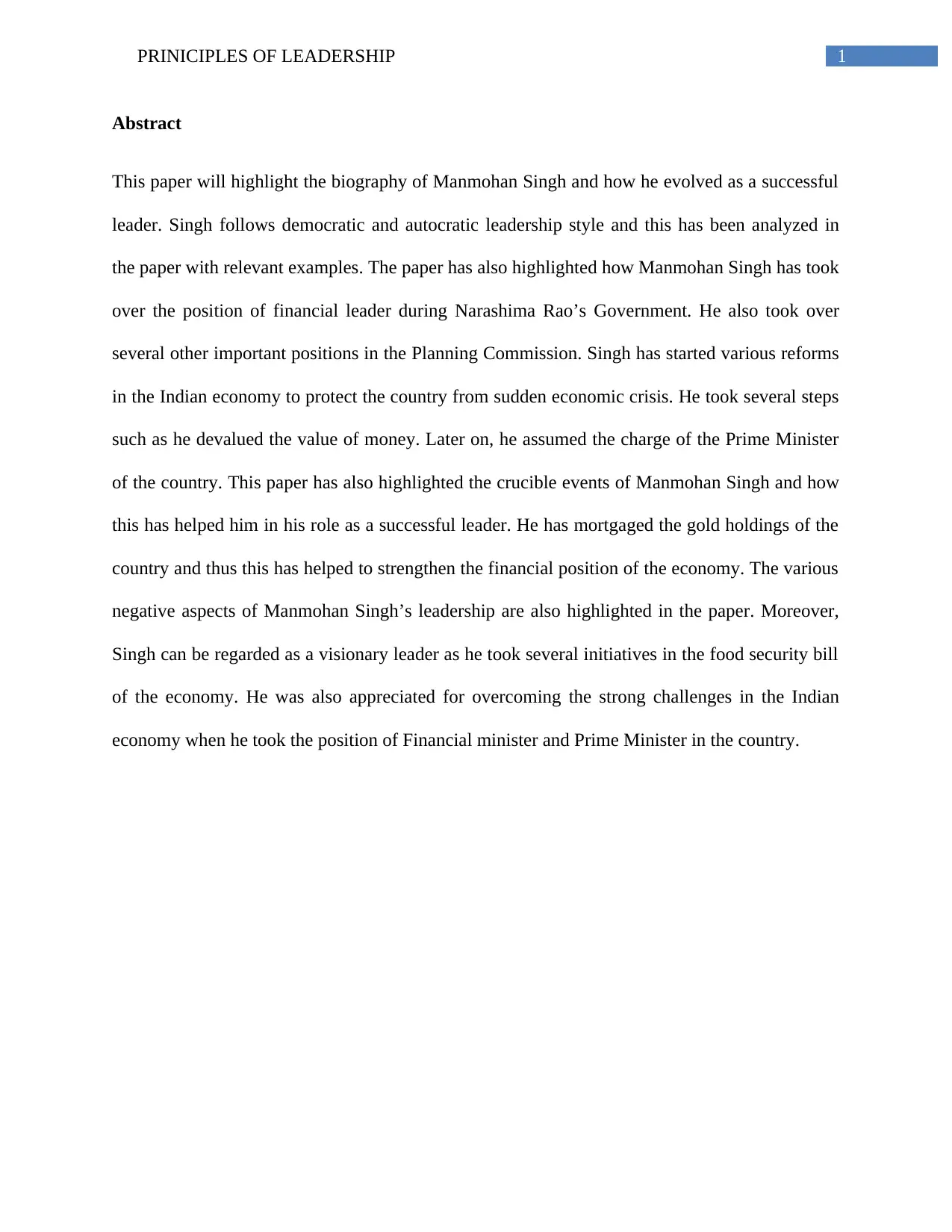
1PRINICIPLES OF LEADERSHIP
Abstract
This paper will highlight the biography of Manmohan Singh and how he evolved as a successful
leader. Singh follows democratic and autocratic leadership style and this has been analyzed in
the paper with relevant examples. The paper has also highlighted how Manmohan Singh has took
over the position of financial leader during Narashima Rao’s Government. He also took over
several other important positions in the Planning Commission. Singh has started various reforms
in the Indian economy to protect the country from sudden economic crisis. He took several steps
such as he devalued the value of money. Later on, he assumed the charge of the Prime Minister
of the country. This paper has also highlighted the crucible events of Manmohan Singh and how
this has helped him in his role as a successful leader. He has mortgaged the gold holdings of the
country and thus this has helped to strengthen the financial position of the economy. The various
negative aspects of Manmohan Singh’s leadership are also highlighted in the paper. Moreover,
Singh can be regarded as a visionary leader as he took several initiatives in the food security bill
of the economy. He was also appreciated for overcoming the strong challenges in the Indian
economy when he took the position of Financial minister and Prime Minister in the country.
Abstract
This paper will highlight the biography of Manmohan Singh and how he evolved as a successful
leader. Singh follows democratic and autocratic leadership style and this has been analyzed in
the paper with relevant examples. The paper has also highlighted how Manmohan Singh has took
over the position of financial leader during Narashima Rao’s Government. He also took over
several other important positions in the Planning Commission. Singh has started various reforms
in the Indian economy to protect the country from sudden economic crisis. He took several steps
such as he devalued the value of money. Later on, he assumed the charge of the Prime Minister
of the country. This paper has also highlighted the crucible events of Manmohan Singh and how
this has helped him in his role as a successful leader. He has mortgaged the gold holdings of the
country and thus this has helped to strengthen the financial position of the economy. The various
negative aspects of Manmohan Singh’s leadership are also highlighted in the paper. Moreover,
Singh can be regarded as a visionary leader as he took several initiatives in the food security bill
of the economy. He was also appreciated for overcoming the strong challenges in the Indian
economy when he took the position of Financial minister and Prime Minister in the country.
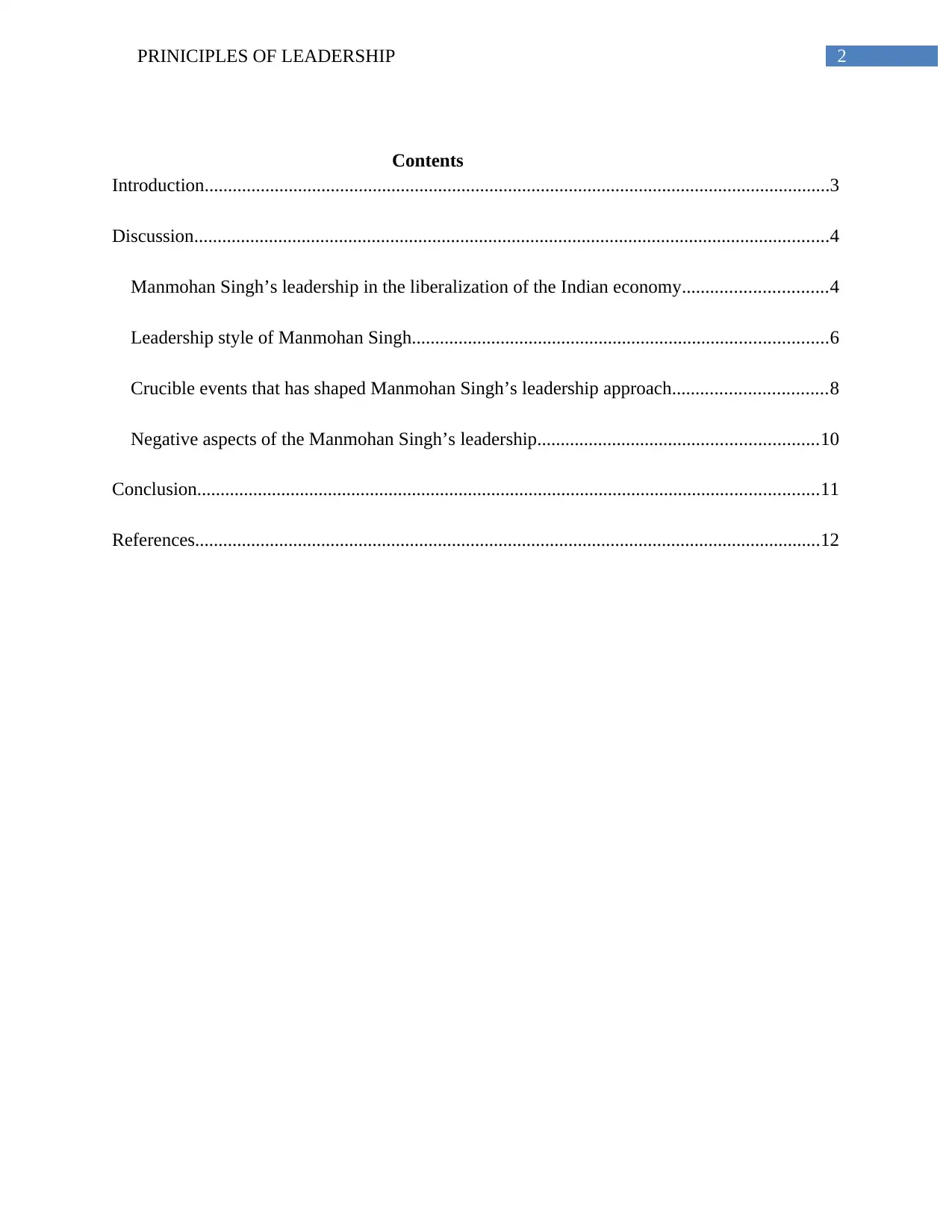
2PRINICIPLES OF LEADERSHIP
Contents
Introduction......................................................................................................................................3
Discussion........................................................................................................................................4
Manmohan Singh’s leadership in the liberalization of the Indian economy...............................4
Leadership style of Manmohan Singh.........................................................................................6
Crucible events that has shaped Manmohan Singh’s leadership approach.................................8
Negative aspects of the Manmohan Singh’s leadership............................................................10
Conclusion.....................................................................................................................................11
References......................................................................................................................................12
Contents
Introduction......................................................................................................................................3
Discussion........................................................................................................................................4
Manmohan Singh’s leadership in the liberalization of the Indian economy...............................4
Leadership style of Manmohan Singh.........................................................................................6
Crucible events that has shaped Manmohan Singh’s leadership approach.................................8
Negative aspects of the Manmohan Singh’s leadership............................................................10
Conclusion.....................................................................................................................................11
References......................................................................................................................................12
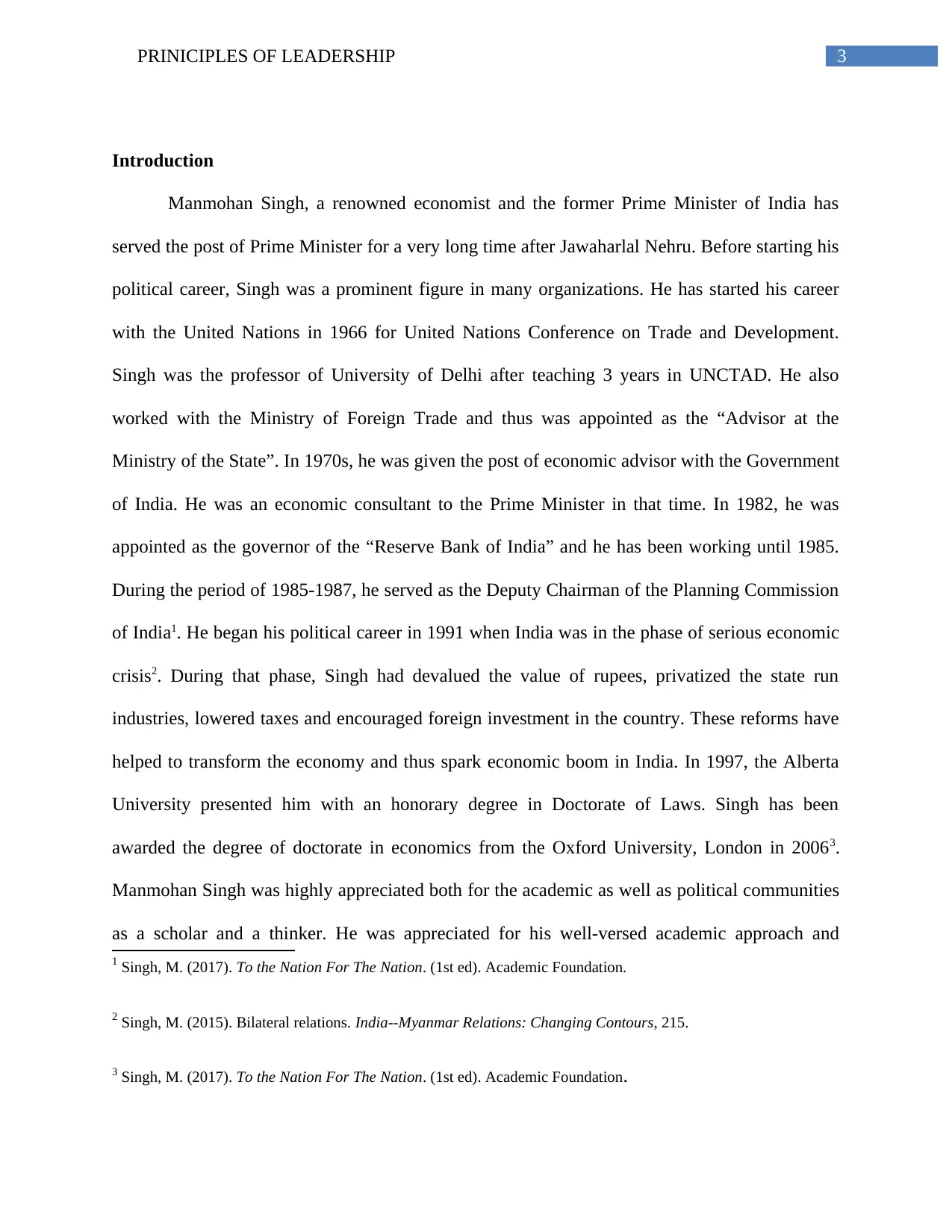
3PRINICIPLES OF LEADERSHIP
Introduction
Manmohan Singh, a renowned economist and the former Prime Minister of India has
served the post of Prime Minister for a very long time after Jawaharlal Nehru. Before starting his
political career, Singh was a prominent figure in many organizations. He has started his career
with the United Nations in 1966 for United Nations Conference on Trade and Development.
Singh was the professor of University of Delhi after teaching 3 years in UNCTAD. He also
worked with the Ministry of Foreign Trade and thus was appointed as the “Advisor at the
Ministry of the State”. In 1970s, he was given the post of economic advisor with the Government
of India. He was an economic consultant to the Prime Minister in that time. In 1982, he was
appointed as the governor of the “Reserve Bank of India” and he has been working until 1985.
During the period of 1985-1987, he served as the Deputy Chairman of the Planning Commission
of India1. He began his political career in 1991 when India was in the phase of serious economic
crisis2. During that phase, Singh had devalued the value of rupees, privatized the state run
industries, lowered taxes and encouraged foreign investment in the country. These reforms have
helped to transform the economy and thus spark economic boom in India. In 1997, the Alberta
University presented him with an honorary degree in Doctorate of Laws. Singh has been
awarded the degree of doctorate in economics from the Oxford University, London in 20063.
Manmohan Singh was highly appreciated both for the academic as well as political communities
as a scholar and a thinker. He was appreciated for his well-versed academic approach and
1 Singh, M. (2017). To the Nation For The Nation. (1st ed). Academic Foundation.
2 Singh, M. (2015). Bilateral relations. India--Myanmar Relations: Changing Contours, 215.
3 Singh, M. (2017). To the Nation For The Nation. (1st ed). Academic Foundation.
Introduction
Manmohan Singh, a renowned economist and the former Prime Minister of India has
served the post of Prime Minister for a very long time after Jawaharlal Nehru. Before starting his
political career, Singh was a prominent figure in many organizations. He has started his career
with the United Nations in 1966 for United Nations Conference on Trade and Development.
Singh was the professor of University of Delhi after teaching 3 years in UNCTAD. He also
worked with the Ministry of Foreign Trade and thus was appointed as the “Advisor at the
Ministry of the State”. In 1970s, he was given the post of economic advisor with the Government
of India. He was an economic consultant to the Prime Minister in that time. In 1982, he was
appointed as the governor of the “Reserve Bank of India” and he has been working until 1985.
During the period of 1985-1987, he served as the Deputy Chairman of the Planning Commission
of India1. He began his political career in 1991 when India was in the phase of serious economic
crisis2. During that phase, Singh had devalued the value of rupees, privatized the state run
industries, lowered taxes and encouraged foreign investment in the country. These reforms have
helped to transform the economy and thus spark economic boom in India. In 1997, the Alberta
University presented him with an honorary degree in Doctorate of Laws. Singh has been
awarded the degree of doctorate in economics from the Oxford University, London in 20063.
Manmohan Singh was highly appreciated both for the academic as well as political communities
as a scholar and a thinker. He was appreciated for his well-versed academic approach and
1 Singh, M. (2017). To the Nation For The Nation. (1st ed). Academic Foundation.
2 Singh, M. (2015). Bilateral relations. India--Myanmar Relations: Changing Contours, 215.
3 Singh, M. (2017). To the Nation For The Nation. (1st ed). Academic Foundation.
Secure Best Marks with AI Grader
Need help grading? Try our AI Grader for instant feedback on your assignments.
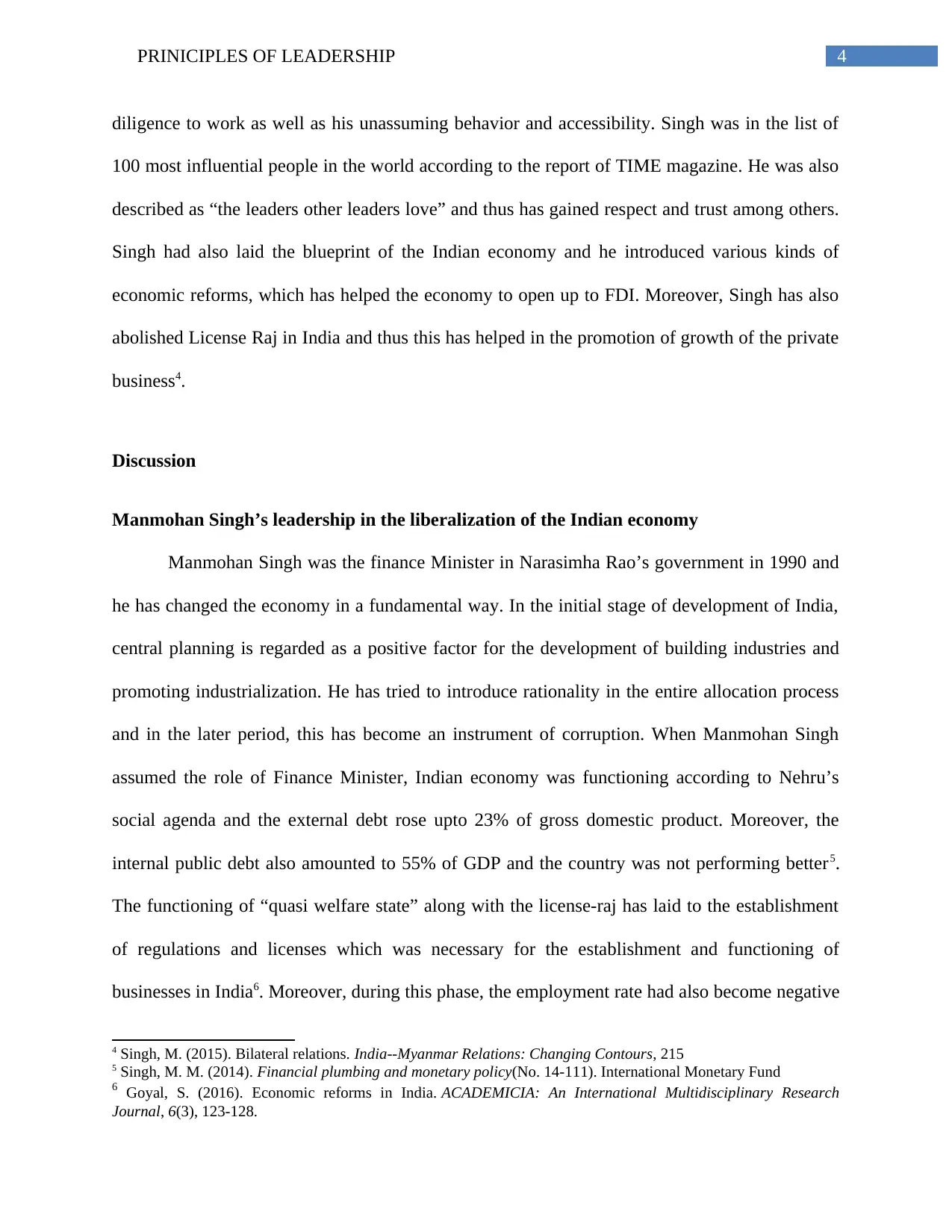
4PRINICIPLES OF LEADERSHIP
diligence to work as well as his unassuming behavior and accessibility. Singh was in the list of
100 most influential people in the world according to the report of TIME magazine. He was also
described as “the leaders other leaders love” and thus has gained respect and trust among others.
Singh had also laid the blueprint of the Indian economy and he introduced various kinds of
economic reforms, which has helped the economy to open up to FDI. Moreover, Singh has also
abolished License Raj in India and thus this has helped in the promotion of growth of the private
business4.
Discussion
Manmohan Singh’s leadership in the liberalization of the Indian economy
Manmohan Singh was the finance Minister in Narasimha Rao’s government in 1990 and
he has changed the economy in a fundamental way. In the initial stage of development of India,
central planning is regarded as a positive factor for the development of building industries and
promoting industrialization. He has tried to introduce rationality in the entire allocation process
and in the later period, this has become an instrument of corruption. When Manmohan Singh
assumed the role of Finance Minister, Indian economy was functioning according to Nehru’s
social agenda and the external debt rose upto 23% of gross domestic product. Moreover, the
internal public debt also amounted to 55% of GDP and the country was not performing better5.
The functioning of “quasi welfare state” along with the license-raj has laid to the establishment
of regulations and licenses which was necessary for the establishment and functioning of
businesses in India6. Moreover, during this phase, the employment rate had also become negative
4 Singh, M. (2015). Bilateral relations. India--Myanmar Relations: Changing Contours, 215
5 Singh, M. M. (2014). Financial plumbing and monetary policy(No. 14-111). International Monetary Fund
6 Goyal, S. (2016). Economic reforms in India. ACADEMICIA: An International Multidisciplinary Research
Journal, 6(3), 123-128.
diligence to work as well as his unassuming behavior and accessibility. Singh was in the list of
100 most influential people in the world according to the report of TIME magazine. He was also
described as “the leaders other leaders love” and thus has gained respect and trust among others.
Singh had also laid the blueprint of the Indian economy and he introduced various kinds of
economic reforms, which has helped the economy to open up to FDI. Moreover, Singh has also
abolished License Raj in India and thus this has helped in the promotion of growth of the private
business4.
Discussion
Manmohan Singh’s leadership in the liberalization of the Indian economy
Manmohan Singh was the finance Minister in Narasimha Rao’s government in 1990 and
he has changed the economy in a fundamental way. In the initial stage of development of India,
central planning is regarded as a positive factor for the development of building industries and
promoting industrialization. He has tried to introduce rationality in the entire allocation process
and in the later period, this has become an instrument of corruption. When Manmohan Singh
assumed the role of Finance Minister, Indian economy was functioning according to Nehru’s
social agenda and the external debt rose upto 23% of gross domestic product. Moreover, the
internal public debt also amounted to 55% of GDP and the country was not performing better5.
The functioning of “quasi welfare state” along with the license-raj has laid to the establishment
of regulations and licenses which was necessary for the establishment and functioning of
businesses in India6. Moreover, during this phase, the employment rate had also become negative
4 Singh, M. (2015). Bilateral relations. India--Myanmar Relations: Changing Contours, 215
5 Singh, M. M. (2014). Financial plumbing and monetary policy(No. 14-111). International Monetary Fund
6 Goyal, S. (2016). Economic reforms in India. ACADEMICIA: An International Multidisciplinary Research
Journal, 6(3), 123-128.
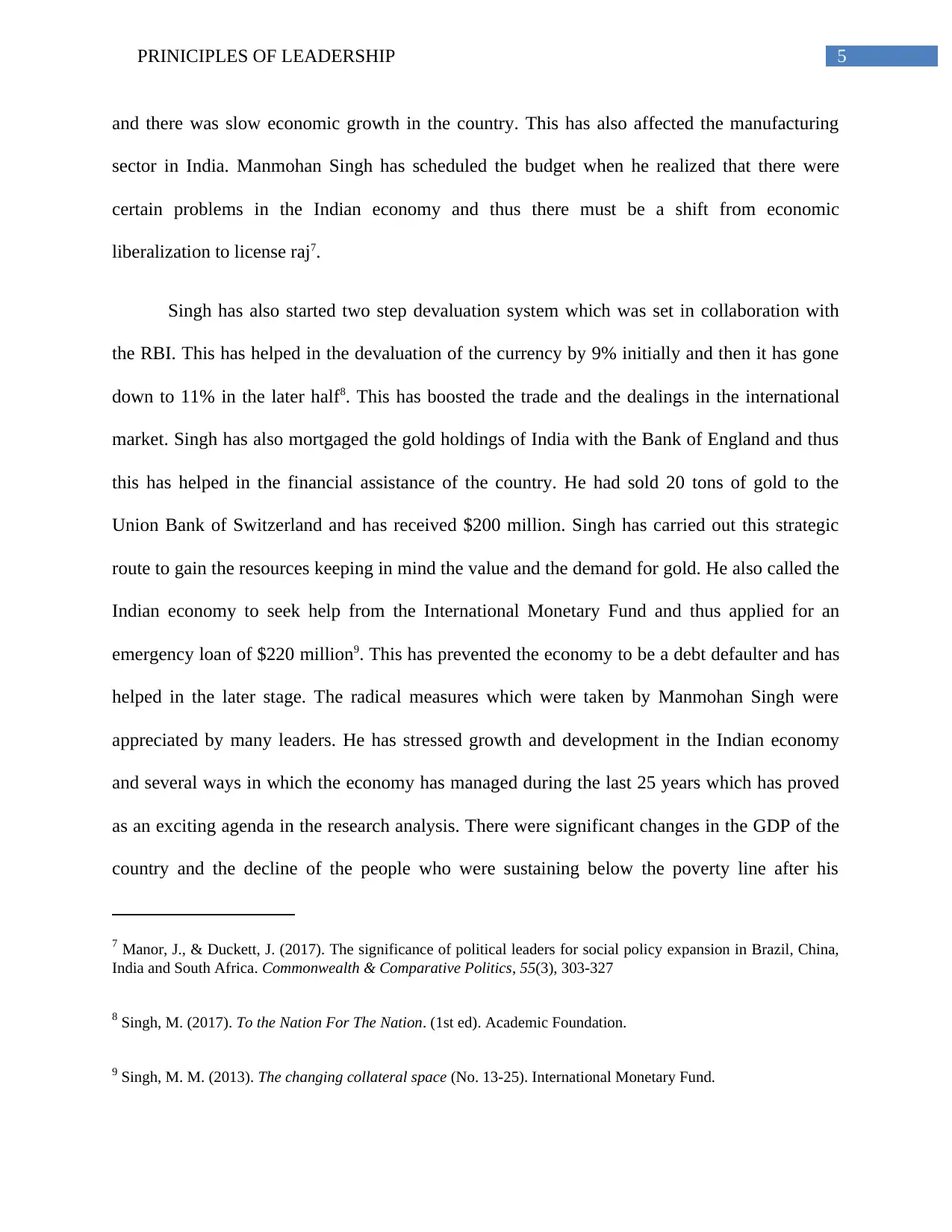
5PRINICIPLES OF LEADERSHIP
and there was slow economic growth in the country. This has also affected the manufacturing
sector in India. Manmohan Singh has scheduled the budget when he realized that there were
certain problems in the Indian economy and thus there must be a shift from economic
liberalization to license raj7.
Singh has also started two step devaluation system which was set in collaboration with
the RBI. This has helped in the devaluation of the currency by 9% initially and then it has gone
down to 11% in the later half8. This has boosted the trade and the dealings in the international
market. Singh has also mortgaged the gold holdings of India with the Bank of England and thus
this has helped in the financial assistance of the country. He had sold 20 tons of gold to the
Union Bank of Switzerland and has received $200 million. Singh has carried out this strategic
route to gain the resources keeping in mind the value and the demand for gold. He also called the
Indian economy to seek help from the International Monetary Fund and thus applied for an
emergency loan of $220 million9. This has prevented the economy to be a debt defaulter and has
helped in the later stage. The radical measures which were taken by Manmohan Singh were
appreciated by many leaders. He has stressed growth and development in the Indian economy
and several ways in which the economy has managed during the last 25 years which has proved
as an exciting agenda in the research analysis. There were significant changes in the GDP of the
country and the decline of the people who were sustaining below the poverty line after his
7 Manor, J., & Duckett, J. (2017). The significance of political leaders for social policy expansion in Brazil, China,
India and South Africa. Commonwealth & Comparative Politics, 55(3), 303-327
8 Singh, M. (2017). To the Nation For The Nation. (1st ed). Academic Foundation.
9 Singh, M. M. (2013). The changing collateral space (No. 13-25). International Monetary Fund.
and there was slow economic growth in the country. This has also affected the manufacturing
sector in India. Manmohan Singh has scheduled the budget when he realized that there were
certain problems in the Indian economy and thus there must be a shift from economic
liberalization to license raj7.
Singh has also started two step devaluation system which was set in collaboration with
the RBI. This has helped in the devaluation of the currency by 9% initially and then it has gone
down to 11% in the later half8. This has boosted the trade and the dealings in the international
market. Singh has also mortgaged the gold holdings of India with the Bank of England and thus
this has helped in the financial assistance of the country. He had sold 20 tons of gold to the
Union Bank of Switzerland and has received $200 million. Singh has carried out this strategic
route to gain the resources keeping in mind the value and the demand for gold. He also called the
Indian economy to seek help from the International Monetary Fund and thus applied for an
emergency loan of $220 million9. This has prevented the economy to be a debt defaulter and has
helped in the later stage. The radical measures which were taken by Manmohan Singh were
appreciated by many leaders. He has stressed growth and development in the Indian economy
and several ways in which the economy has managed during the last 25 years which has proved
as an exciting agenda in the research analysis. There were significant changes in the GDP of the
country and the decline of the people who were sustaining below the poverty line after his
7 Manor, J., & Duckett, J. (2017). The significance of political leaders for social policy expansion in Brazil, China,
India and South Africa. Commonwealth & Comparative Politics, 55(3), 303-327
8 Singh, M. (2017). To the Nation For The Nation. (1st ed). Academic Foundation.
9 Singh, M. M. (2013). The changing collateral space (No. 13-25). International Monetary Fund.
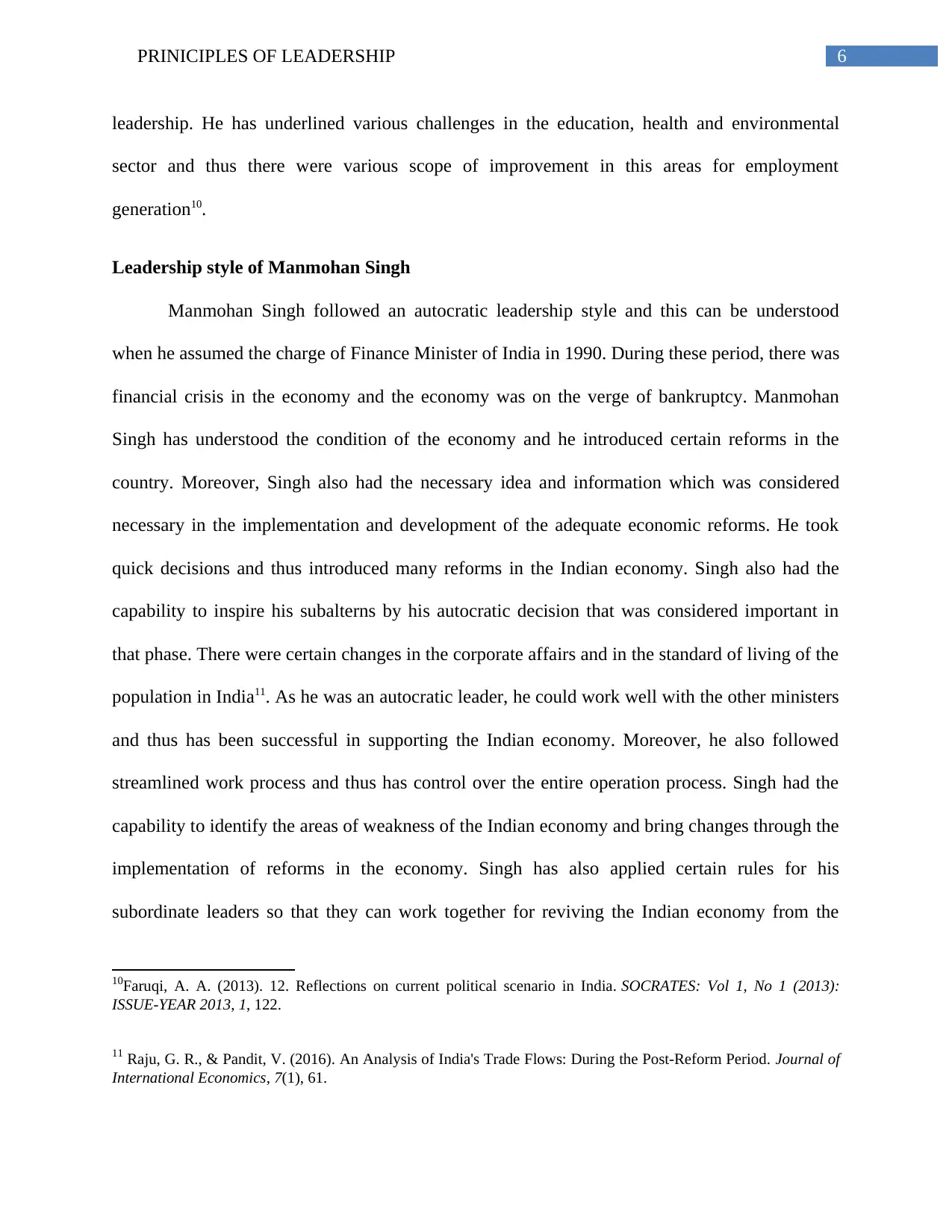
6PRINICIPLES OF LEADERSHIP
leadership. He has underlined various challenges in the education, health and environmental
sector and thus there were various scope of improvement in this areas for employment
generation10.
Leadership style of Manmohan Singh
Manmohan Singh followed an autocratic leadership style and this can be understood
when he assumed the charge of Finance Minister of India in 1990. During these period, there was
financial crisis in the economy and the economy was on the verge of bankruptcy. Manmohan
Singh has understood the condition of the economy and he introduced certain reforms in the
country. Moreover, Singh also had the necessary idea and information which was considered
necessary in the implementation and development of the adequate economic reforms. He took
quick decisions and thus introduced many reforms in the Indian economy. Singh also had the
capability to inspire his subalterns by his autocratic decision that was considered important in
that phase. There were certain changes in the corporate affairs and in the standard of living of the
population in India11. As he was an autocratic leader, he could work well with the other ministers
and thus has been successful in supporting the Indian economy. Moreover, he also followed
streamlined work process and thus has control over the entire operation process. Singh had the
capability to identify the areas of weakness of the Indian economy and bring changes through the
implementation of reforms in the economy. Singh has also applied certain rules for his
subordinate leaders so that they can work together for reviving the Indian economy from the
10Faruqi, A. A. (2013). 12. Reflections on current political scenario in India. SOCRATES: Vol 1, No 1 (2013):
ISSUE-YEAR 2013, 1, 122.
11 Raju, G. R., & Pandit, V. (2016). An Analysis of India's Trade Flows: During the Post-Reform Period. Journal of
International Economics, 7(1), 61.
leadership. He has underlined various challenges in the education, health and environmental
sector and thus there were various scope of improvement in this areas for employment
generation10.
Leadership style of Manmohan Singh
Manmohan Singh followed an autocratic leadership style and this can be understood
when he assumed the charge of Finance Minister of India in 1990. During these period, there was
financial crisis in the economy and the economy was on the verge of bankruptcy. Manmohan
Singh has understood the condition of the economy and he introduced certain reforms in the
country. Moreover, Singh also had the necessary idea and information which was considered
necessary in the implementation and development of the adequate economic reforms. He took
quick decisions and thus introduced many reforms in the Indian economy. Singh also had the
capability to inspire his subalterns by his autocratic decision that was considered important in
that phase. There were certain changes in the corporate affairs and in the standard of living of the
population in India11. As he was an autocratic leader, he could work well with the other ministers
and thus has been successful in supporting the Indian economy. Moreover, he also followed
streamlined work process and thus has control over the entire operation process. Singh had the
capability to identify the areas of weakness of the Indian economy and bring changes through the
implementation of reforms in the economy. Singh has also applied certain rules for his
subordinate leaders so that they can work together for reviving the Indian economy from the
10Faruqi, A. A. (2013). 12. Reflections on current political scenario in India. SOCRATES: Vol 1, No 1 (2013):
ISSUE-YEAR 2013, 1, 122.
11 Raju, G. R., & Pandit, V. (2016). An Analysis of India's Trade Flows: During the Post-Reform Period. Journal of
International Economics, 7(1), 61.
Paraphrase This Document
Need a fresh take? Get an instant paraphrase of this document with our AI Paraphraser
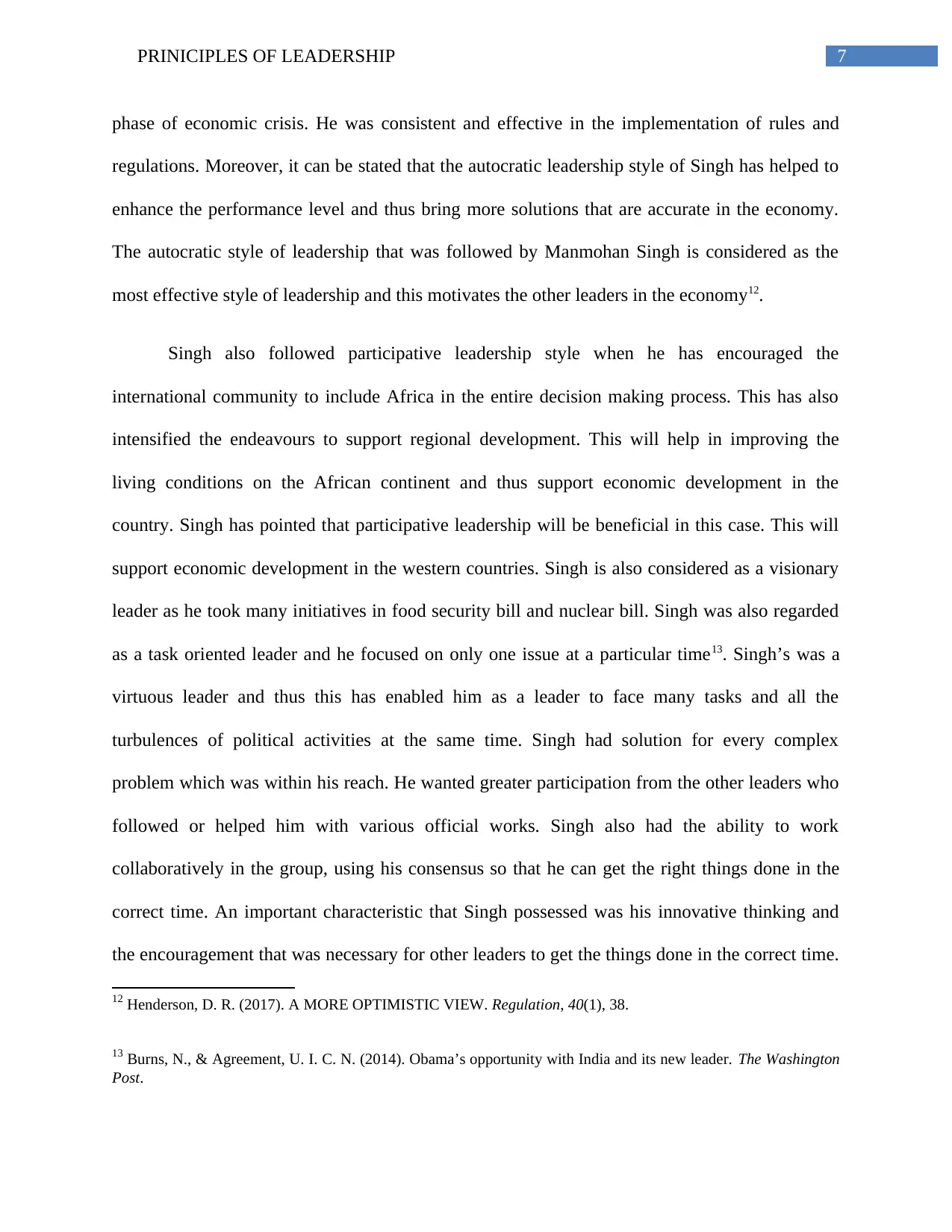
7PRINICIPLES OF LEADERSHIP
phase of economic crisis. He was consistent and effective in the implementation of rules and
regulations. Moreover, it can be stated that the autocratic leadership style of Singh has helped to
enhance the performance level and thus bring more solutions that are accurate in the economy.
The autocratic style of leadership that was followed by Manmohan Singh is considered as the
most effective style of leadership and this motivates the other leaders in the economy12.
Singh also followed participative leadership style when he has encouraged the
international community to include Africa in the entire decision making process. This has also
intensified the endeavours to support regional development. This will help in improving the
living conditions on the African continent and thus support economic development in the
country. Singh has pointed that participative leadership will be beneficial in this case. This will
support economic development in the western countries. Singh is also considered as a visionary
leader as he took many initiatives in food security bill and nuclear bill. Singh was also regarded
as a task oriented leader and he focused on only one issue at a particular time13. Singh’s was a
virtuous leader and thus this has enabled him as a leader to face many tasks and all the
turbulences of political activities at the same time. Singh had solution for every complex
problem which was within his reach. He wanted greater participation from the other leaders who
followed or helped him with various official works. Singh also had the ability to work
collaboratively in the group, using his consensus so that he can get the right things done in the
correct time. An important characteristic that Singh possessed was his innovative thinking and
the encouragement that was necessary for other leaders to get the things done in the correct time.
12 Henderson, D. R. (2017). A MORE OPTIMISTIC VIEW. Regulation, 40(1), 38.
13 Burns, N., & Agreement, U. I. C. N. (2014). Obama’s opportunity with India and its new leader. The Washington
Post.
phase of economic crisis. He was consistent and effective in the implementation of rules and
regulations. Moreover, it can be stated that the autocratic leadership style of Singh has helped to
enhance the performance level and thus bring more solutions that are accurate in the economy.
The autocratic style of leadership that was followed by Manmohan Singh is considered as the
most effective style of leadership and this motivates the other leaders in the economy12.
Singh also followed participative leadership style when he has encouraged the
international community to include Africa in the entire decision making process. This has also
intensified the endeavours to support regional development. This will help in improving the
living conditions on the African continent and thus support economic development in the
country. Singh has pointed that participative leadership will be beneficial in this case. This will
support economic development in the western countries. Singh is also considered as a visionary
leader as he took many initiatives in food security bill and nuclear bill. Singh was also regarded
as a task oriented leader and he focused on only one issue at a particular time13. Singh’s was a
virtuous leader and thus this has enabled him as a leader to face many tasks and all the
turbulences of political activities at the same time. Singh had solution for every complex
problem which was within his reach. He wanted greater participation from the other leaders who
followed or helped him with various official works. Singh also had the ability to work
collaboratively in the group, using his consensus so that he can get the right things done in the
correct time. An important characteristic that Singh possessed was his innovative thinking and
the encouragement that was necessary for other leaders to get the things done in the correct time.
12 Henderson, D. R. (2017). A MORE OPTIMISTIC VIEW. Regulation, 40(1), 38.
13 Burns, N., & Agreement, U. I. C. N. (2014). Obama’s opportunity with India and its new leader. The Washington
Post.
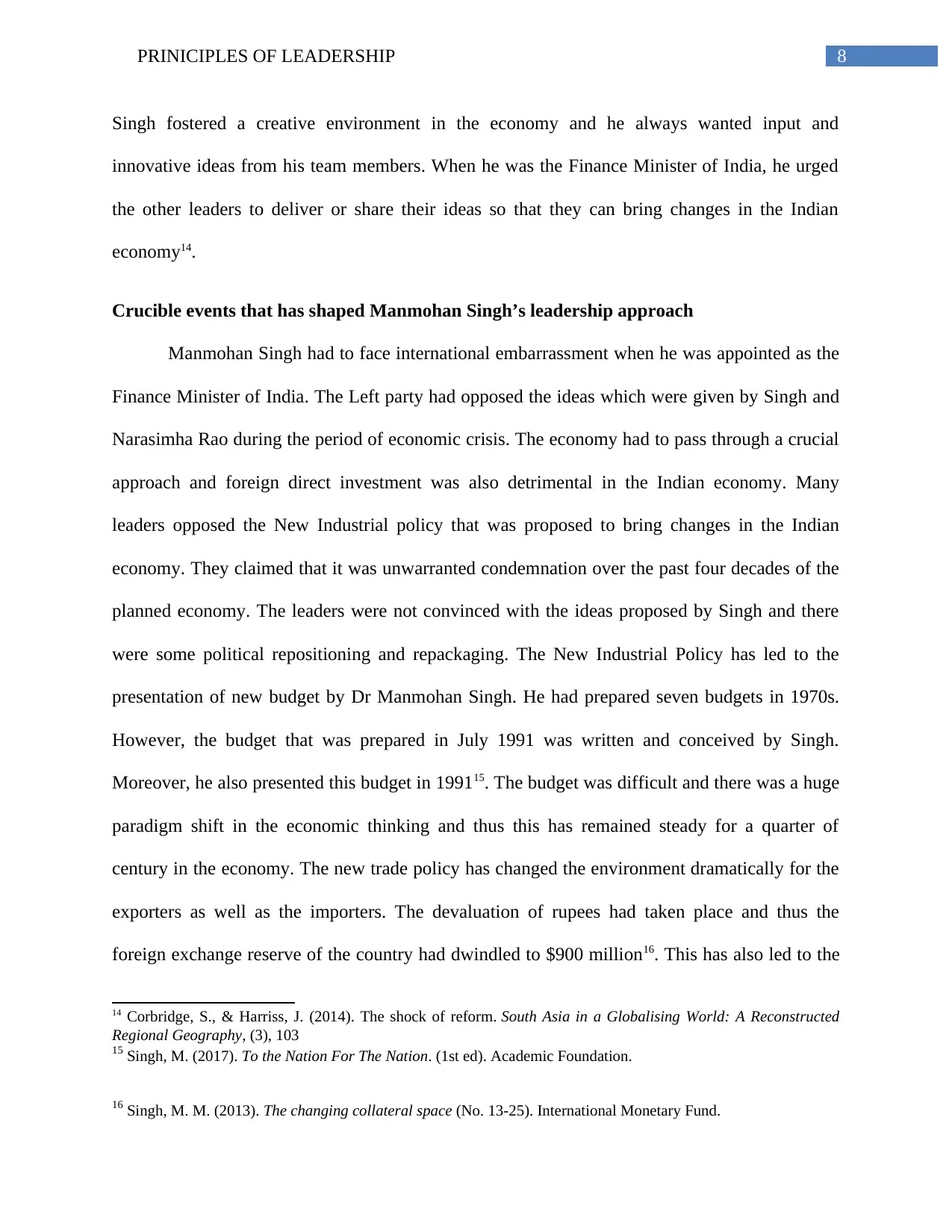
8PRINICIPLES OF LEADERSHIP
Singh fostered a creative environment in the economy and he always wanted input and
innovative ideas from his team members. When he was the Finance Minister of India, he urged
the other leaders to deliver or share their ideas so that they can bring changes in the Indian
economy14.
Crucible events that has shaped Manmohan Singh’s leadership approach
Manmohan Singh had to face international embarrassment when he was appointed as the
Finance Minister of India. The Left party had opposed the ideas which were given by Singh and
Narasimha Rao during the period of economic crisis. The economy had to pass through a crucial
approach and foreign direct investment was also detrimental in the Indian economy. Many
leaders opposed the New Industrial policy that was proposed to bring changes in the Indian
economy. They claimed that it was unwarranted condemnation over the past four decades of the
planned economy. The leaders were not convinced with the ideas proposed by Singh and there
were some political repositioning and repackaging. The New Industrial Policy has led to the
presentation of new budget by Dr Manmohan Singh. He had prepared seven budgets in 1970s.
However, the budget that was prepared in July 1991 was written and conceived by Singh.
Moreover, he also presented this budget in 199115. The budget was difficult and there was a huge
paradigm shift in the economic thinking and thus this has remained steady for a quarter of
century in the economy. The new trade policy has changed the environment dramatically for the
exporters as well as the importers. The devaluation of rupees had taken place and thus the
foreign exchange reserve of the country had dwindled to $900 million16. This has also led to the
14 Corbridge, S., & Harriss, J. (2014). The shock of reform. South Asia in a Globalising World: A Reconstructed
Regional Geography, (3), 103
15 Singh, M. (2017). To the Nation For The Nation. (1st ed). Academic Foundation.
16 Singh, M. M. (2013). The changing collateral space (No. 13-25). International Monetary Fund.
Singh fostered a creative environment in the economy and he always wanted input and
innovative ideas from his team members. When he was the Finance Minister of India, he urged
the other leaders to deliver or share their ideas so that they can bring changes in the Indian
economy14.
Crucible events that has shaped Manmohan Singh’s leadership approach
Manmohan Singh had to face international embarrassment when he was appointed as the
Finance Minister of India. The Left party had opposed the ideas which were given by Singh and
Narasimha Rao during the period of economic crisis. The economy had to pass through a crucial
approach and foreign direct investment was also detrimental in the Indian economy. Many
leaders opposed the New Industrial policy that was proposed to bring changes in the Indian
economy. They claimed that it was unwarranted condemnation over the past four decades of the
planned economy. The leaders were not convinced with the ideas proposed by Singh and there
were some political repositioning and repackaging. The New Industrial Policy has led to the
presentation of new budget by Dr Manmohan Singh. He had prepared seven budgets in 1970s.
However, the budget that was prepared in July 1991 was written and conceived by Singh.
Moreover, he also presented this budget in 199115. The budget was difficult and there was a huge
paradigm shift in the economic thinking and thus this has remained steady for a quarter of
century in the economy. The new trade policy has changed the environment dramatically for the
exporters as well as the importers. The devaluation of rupees had taken place and thus the
foreign exchange reserve of the country had dwindled to $900 million16. This has also led to the
14 Corbridge, S., & Harriss, J. (2014). The shock of reform. South Asia in a Globalising World: A Reconstructed
Regional Geography, (3), 103
15 Singh, M. (2017). To the Nation For The Nation. (1st ed). Academic Foundation.
16 Singh, M. M. (2013). The changing collateral space (No. 13-25). International Monetary Fund.
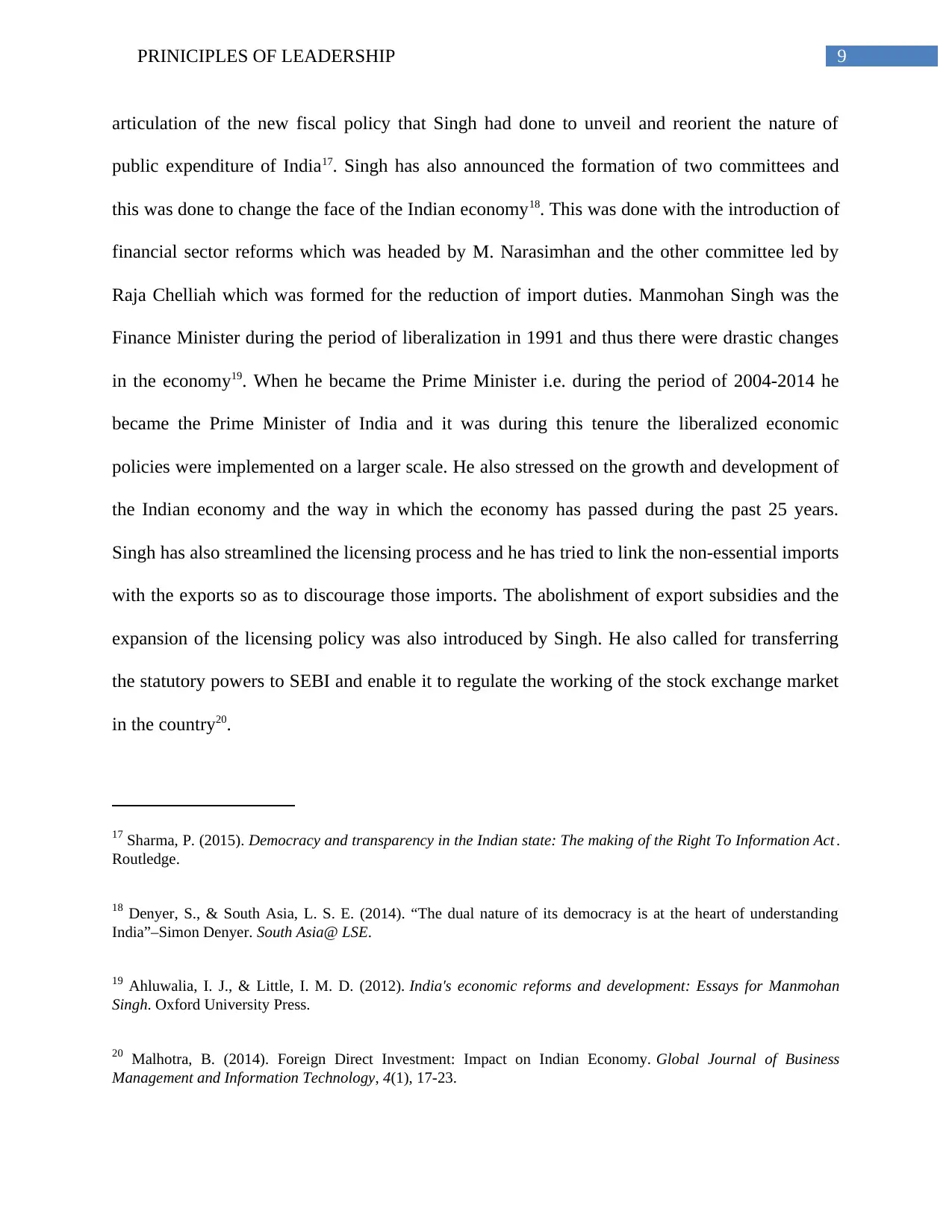
9PRINICIPLES OF LEADERSHIP
articulation of the new fiscal policy that Singh had done to unveil and reorient the nature of
public expenditure of India17. Singh has also announced the formation of two committees and
this was done to change the face of the Indian economy18. This was done with the introduction of
financial sector reforms which was headed by M. Narasimhan and the other committee led by
Raja Chelliah which was formed for the reduction of import duties. Manmohan Singh was the
Finance Minister during the period of liberalization in 1991 and thus there were drastic changes
in the economy19. When he became the Prime Minister i.e. during the period of 2004-2014 he
became the Prime Minister of India and it was during this tenure the liberalized economic
policies were implemented on a larger scale. He also stressed on the growth and development of
the Indian economy and the way in which the economy has passed during the past 25 years.
Singh has also streamlined the licensing process and he has tried to link the non-essential imports
with the exports so as to discourage those imports. The abolishment of export subsidies and the
expansion of the licensing policy was also introduced by Singh. He also called for transferring
the statutory powers to SEBI and enable it to regulate the working of the stock exchange market
in the country20.
17 Sharma, P. (2015). Democracy and transparency in the Indian state: The making of the Right To Information Act .
Routledge.
18 Denyer, S., & South Asia, L. S. E. (2014). “The dual nature of its democracy is at the heart of understanding
India”–Simon Denyer. South Asia@ LSE.
19 Ahluwalia, I. J., & Little, I. M. D. (2012). India's economic reforms and development: Essays for Manmohan
Singh. Oxford University Press.
20 Malhotra, B. (2014). Foreign Direct Investment: Impact on Indian Economy. Global Journal of Business
Management and Information Technology, 4(1), 17-23.
articulation of the new fiscal policy that Singh had done to unveil and reorient the nature of
public expenditure of India17. Singh has also announced the formation of two committees and
this was done to change the face of the Indian economy18. This was done with the introduction of
financial sector reforms which was headed by M. Narasimhan and the other committee led by
Raja Chelliah which was formed for the reduction of import duties. Manmohan Singh was the
Finance Minister during the period of liberalization in 1991 and thus there were drastic changes
in the economy19. When he became the Prime Minister i.e. during the period of 2004-2014 he
became the Prime Minister of India and it was during this tenure the liberalized economic
policies were implemented on a larger scale. He also stressed on the growth and development of
the Indian economy and the way in which the economy has passed during the past 25 years.
Singh has also streamlined the licensing process and he has tried to link the non-essential imports
with the exports so as to discourage those imports. The abolishment of export subsidies and the
expansion of the licensing policy was also introduced by Singh. He also called for transferring
the statutory powers to SEBI and enable it to regulate the working of the stock exchange market
in the country20.
17 Sharma, P. (2015). Democracy and transparency in the Indian state: The making of the Right To Information Act .
Routledge.
18 Denyer, S., & South Asia, L. S. E. (2014). “The dual nature of its democracy is at the heart of understanding
India”–Simon Denyer. South Asia@ LSE.
19 Ahluwalia, I. J., & Little, I. M. D. (2012). India's economic reforms and development: Essays for Manmohan
Singh. Oxford University Press.
20 Malhotra, B. (2014). Foreign Direct Investment: Impact on Indian Economy. Global Journal of Business
Management and Information Technology, 4(1), 17-23.
Secure Best Marks with AI Grader
Need help grading? Try our AI Grader for instant feedback on your assignments.
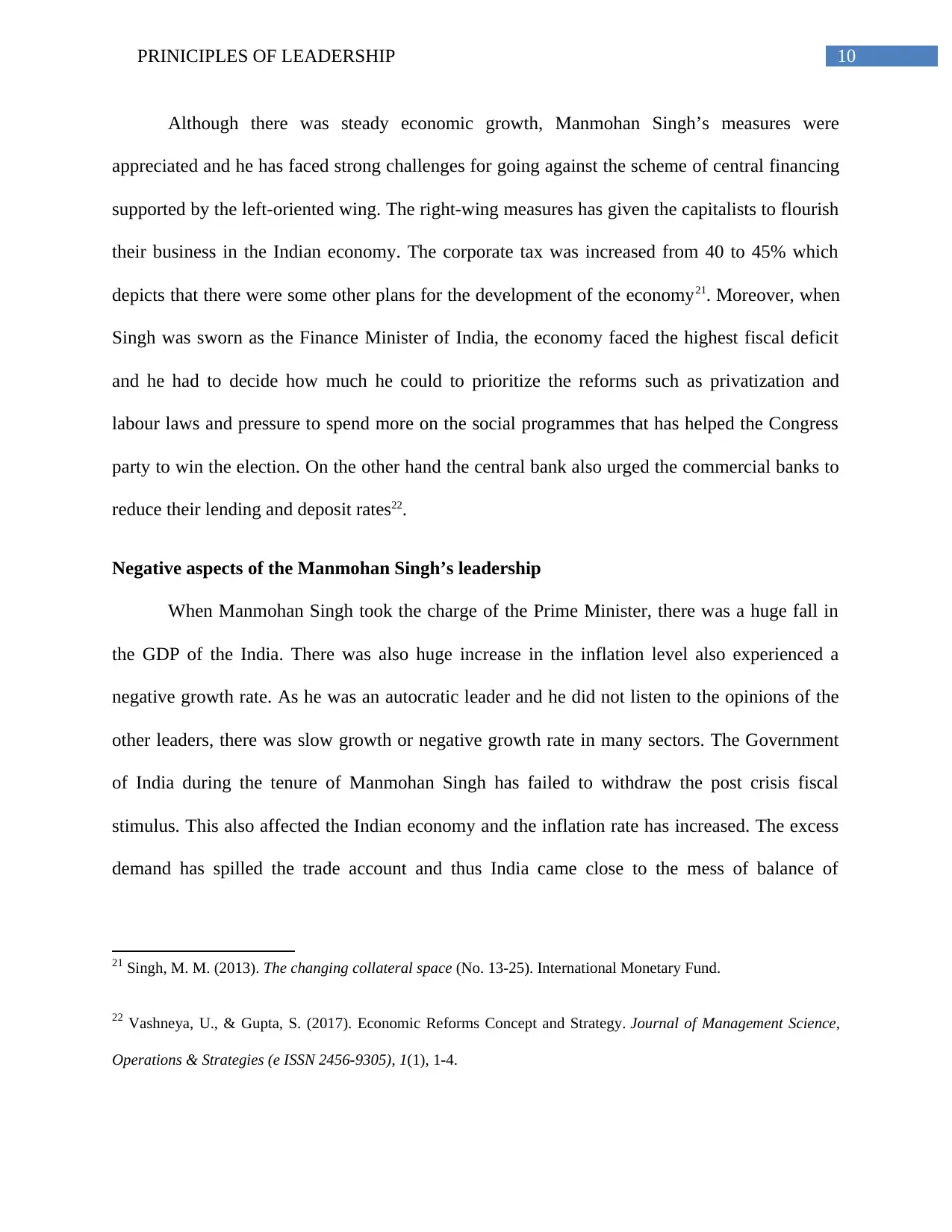
10PRINICIPLES OF LEADERSHIP
Although there was steady economic growth, Manmohan Singh’s measures were
appreciated and he has faced strong challenges for going against the scheme of central financing
supported by the left-oriented wing. The right-wing measures has given the capitalists to flourish
their business in the Indian economy. The corporate tax was increased from 40 to 45% which
depicts that there were some other plans for the development of the economy21. Moreover, when
Singh was sworn as the Finance Minister of India, the economy faced the highest fiscal deficit
and he had to decide how much he could to prioritize the reforms such as privatization and
labour laws and pressure to spend more on the social programmes that has helped the Congress
party to win the election. On the other hand the central bank also urged the commercial banks to
reduce their lending and deposit rates22.
Negative aspects of the Manmohan Singh’s leadership
When Manmohan Singh took the charge of the Prime Minister, there was a huge fall in
the GDP of the India. There was also huge increase in the inflation level also experienced a
negative growth rate. As he was an autocratic leader and he did not listen to the opinions of the
other leaders, there was slow growth or negative growth rate in many sectors. The Government
of India during the tenure of Manmohan Singh has failed to withdraw the post crisis fiscal
stimulus. This also affected the Indian economy and the inflation rate has increased. The excess
demand has spilled the trade account and thus India came close to the mess of balance of
21 Singh, M. M. (2013). The changing collateral space (No. 13-25). International Monetary Fund.
22 Vashneya, U., & Gupta, S. (2017). Economic Reforms Concept and Strategy. Journal of Management Science,
Operations & Strategies (e ISSN 2456-9305), 1(1), 1-4.
Although there was steady economic growth, Manmohan Singh’s measures were
appreciated and he has faced strong challenges for going against the scheme of central financing
supported by the left-oriented wing. The right-wing measures has given the capitalists to flourish
their business in the Indian economy. The corporate tax was increased from 40 to 45% which
depicts that there were some other plans for the development of the economy21. Moreover, when
Singh was sworn as the Finance Minister of India, the economy faced the highest fiscal deficit
and he had to decide how much he could to prioritize the reforms such as privatization and
labour laws and pressure to spend more on the social programmes that has helped the Congress
party to win the election. On the other hand the central bank also urged the commercial banks to
reduce their lending and deposit rates22.
Negative aspects of the Manmohan Singh’s leadership
When Manmohan Singh took the charge of the Prime Minister, there was a huge fall in
the GDP of the India. There was also huge increase in the inflation level also experienced a
negative growth rate. As he was an autocratic leader and he did not listen to the opinions of the
other leaders, there was slow growth or negative growth rate in many sectors. The Government
of India during the tenure of Manmohan Singh has failed to withdraw the post crisis fiscal
stimulus. This also affected the Indian economy and the inflation rate has increased. The excess
demand has spilled the trade account and thus India came close to the mess of balance of
21 Singh, M. M. (2013). The changing collateral space (No. 13-25). International Monetary Fund.
22 Vashneya, U., & Gupta, S. (2017). Economic Reforms Concept and Strategy. Journal of Management Science,
Operations & Strategies (e ISSN 2456-9305), 1(1), 1-4.
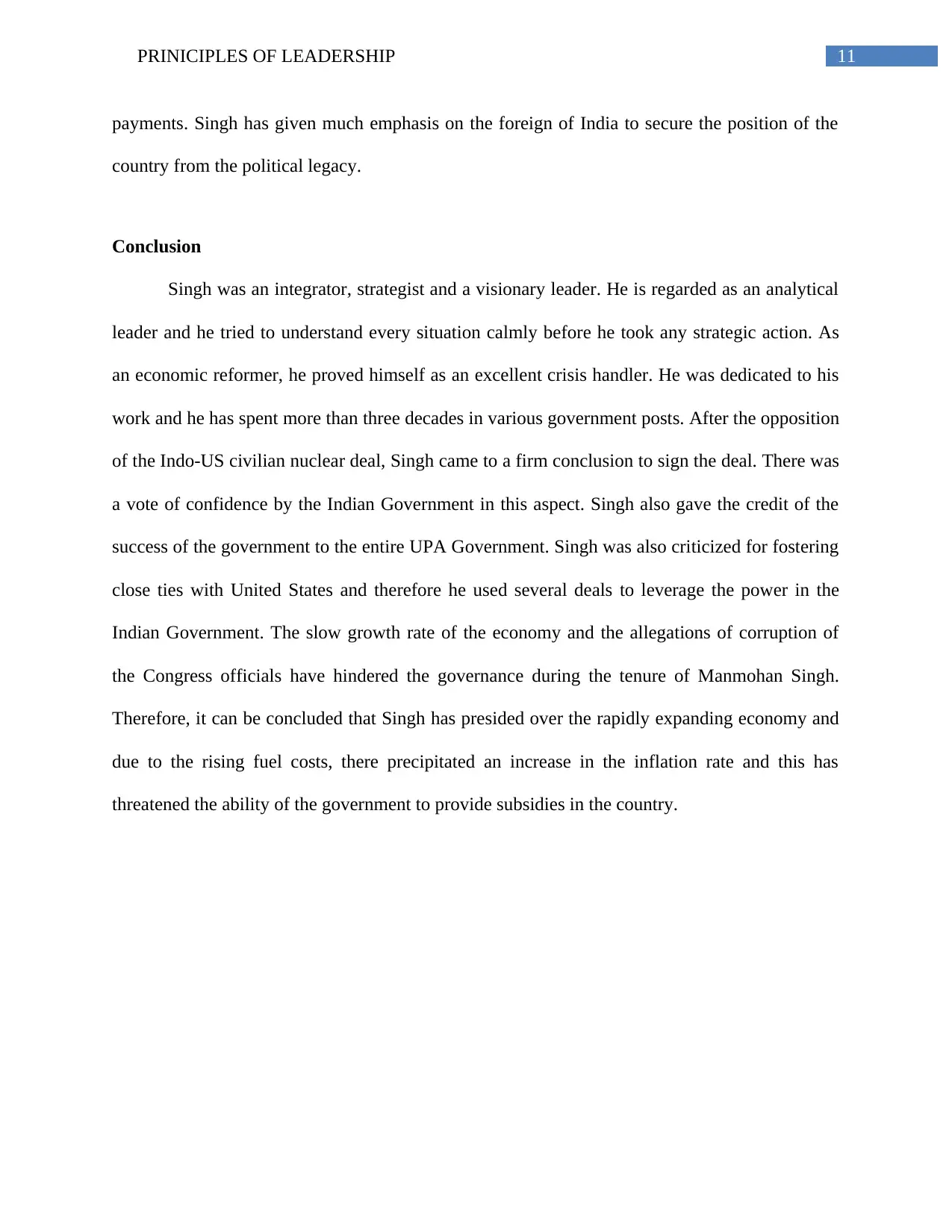
11PRINICIPLES OF LEADERSHIP
payments. Singh has given much emphasis on the foreign of India to secure the position of the
country from the political legacy.
Conclusion
Singh was an integrator, strategist and a visionary leader. He is regarded as an analytical
leader and he tried to understand every situation calmly before he took any strategic action. As
an economic reformer, he proved himself as an excellent crisis handler. He was dedicated to his
work and he has spent more than three decades in various government posts. After the opposition
of the Indo-US civilian nuclear deal, Singh came to a firm conclusion to sign the deal. There was
a vote of confidence by the Indian Government in this aspect. Singh also gave the credit of the
success of the government to the entire UPA Government. Singh was also criticized for fostering
close ties with United States and therefore he used several deals to leverage the power in the
Indian Government. The slow growth rate of the economy and the allegations of corruption of
the Congress officials have hindered the governance during the tenure of Manmohan Singh.
Therefore, it can be concluded that Singh has presided over the rapidly expanding economy and
due to the rising fuel costs, there precipitated an increase in the inflation rate and this has
threatened the ability of the government to provide subsidies in the country.
payments. Singh has given much emphasis on the foreign of India to secure the position of the
country from the political legacy.
Conclusion
Singh was an integrator, strategist and a visionary leader. He is regarded as an analytical
leader and he tried to understand every situation calmly before he took any strategic action. As
an economic reformer, he proved himself as an excellent crisis handler. He was dedicated to his
work and he has spent more than three decades in various government posts. After the opposition
of the Indo-US civilian nuclear deal, Singh came to a firm conclusion to sign the deal. There was
a vote of confidence by the Indian Government in this aspect. Singh also gave the credit of the
success of the government to the entire UPA Government. Singh was also criticized for fostering
close ties with United States and therefore he used several deals to leverage the power in the
Indian Government. The slow growth rate of the economy and the allegations of corruption of
the Congress officials have hindered the governance during the tenure of Manmohan Singh.
Therefore, it can be concluded that Singh has presided over the rapidly expanding economy and
due to the rising fuel costs, there precipitated an increase in the inflation rate and this has
threatened the ability of the government to provide subsidies in the country.
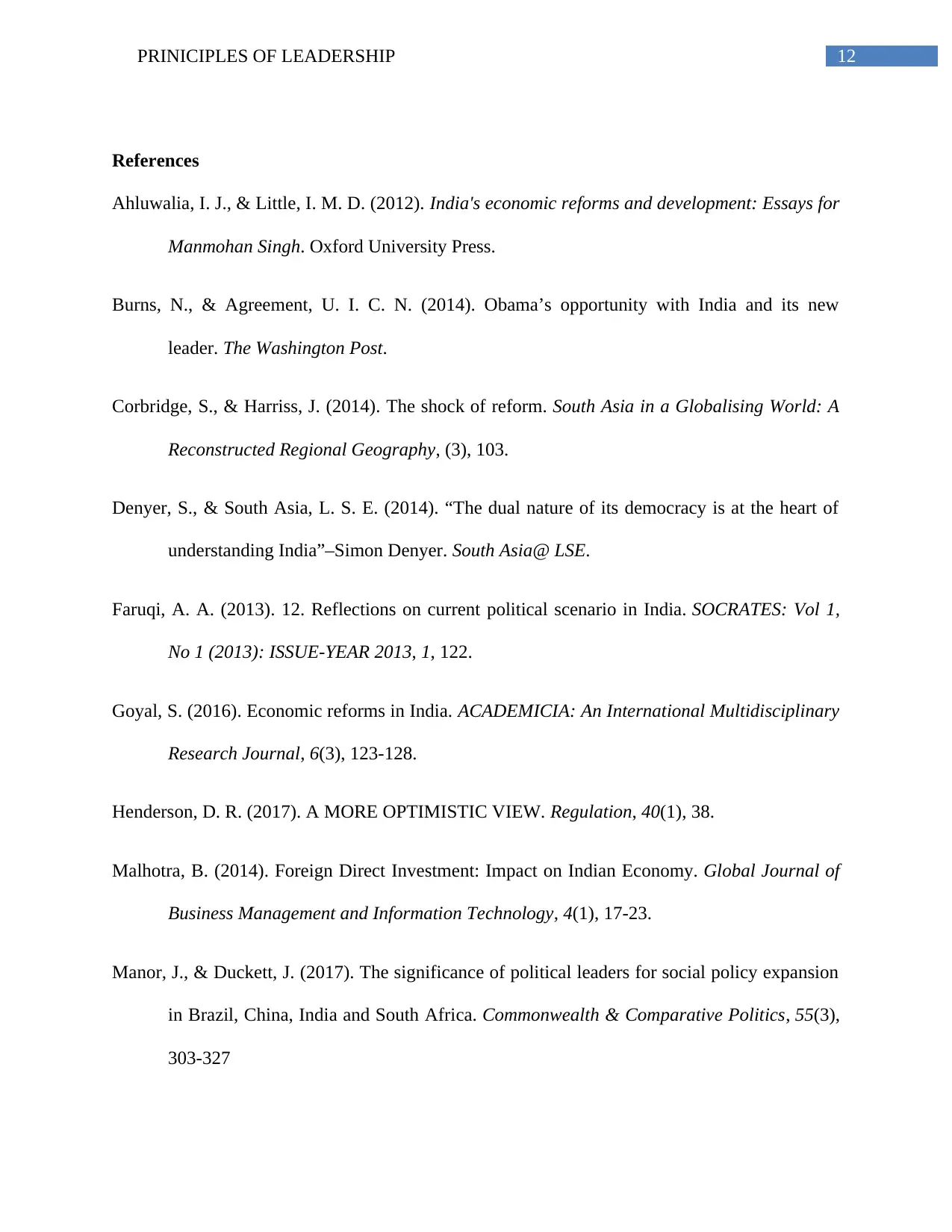
12PRINICIPLES OF LEADERSHIP
References
Ahluwalia, I. J., & Little, I. M. D. (2012). India's economic reforms and development: Essays for
Manmohan Singh. Oxford University Press.
Burns, N., & Agreement, U. I. C. N. (2014). Obama’s opportunity with India and its new
leader. The Washington Post.
Corbridge, S., & Harriss, J. (2014). The shock of reform. South Asia in a Globalising World: A
Reconstructed Regional Geography, (3), 103.
Denyer, S., & South Asia, L. S. E. (2014). “The dual nature of its democracy is at the heart of
understanding India”–Simon Denyer. South Asia@ LSE.
Faruqi, A. A. (2013). 12. Reflections on current political scenario in India. SOCRATES: Vol 1,
No 1 (2013): ISSUE-YEAR 2013, 1, 122.
Goyal, S. (2016). Economic reforms in India. ACADEMICIA: An International Multidisciplinary
Research Journal, 6(3), 123-128.
Henderson, D. R. (2017). A MORE OPTIMISTIC VIEW. Regulation, 40(1), 38.
Malhotra, B. (2014). Foreign Direct Investment: Impact on Indian Economy. Global Journal of
Business Management and Information Technology, 4(1), 17-23.
Manor, J., & Duckett, J. (2017). The significance of political leaders for social policy expansion
in Brazil, China, India and South Africa. Commonwealth & Comparative Politics, 55(3),
303-327
References
Ahluwalia, I. J., & Little, I. M. D. (2012). India's economic reforms and development: Essays for
Manmohan Singh. Oxford University Press.
Burns, N., & Agreement, U. I. C. N. (2014). Obama’s opportunity with India and its new
leader. The Washington Post.
Corbridge, S., & Harriss, J. (2014). The shock of reform. South Asia in a Globalising World: A
Reconstructed Regional Geography, (3), 103.
Denyer, S., & South Asia, L. S. E. (2014). “The dual nature of its democracy is at the heart of
understanding India”–Simon Denyer. South Asia@ LSE.
Faruqi, A. A. (2013). 12. Reflections on current political scenario in India. SOCRATES: Vol 1,
No 1 (2013): ISSUE-YEAR 2013, 1, 122.
Goyal, S. (2016). Economic reforms in India. ACADEMICIA: An International Multidisciplinary
Research Journal, 6(3), 123-128.
Henderson, D. R. (2017). A MORE OPTIMISTIC VIEW. Regulation, 40(1), 38.
Malhotra, B. (2014). Foreign Direct Investment: Impact on Indian Economy. Global Journal of
Business Management and Information Technology, 4(1), 17-23.
Manor, J., & Duckett, J. (2017). The significance of political leaders for social policy expansion
in Brazil, China, India and South Africa. Commonwealth & Comparative Politics, 55(3),
303-327
Paraphrase This Document
Need a fresh take? Get an instant paraphrase of this document with our AI Paraphraser
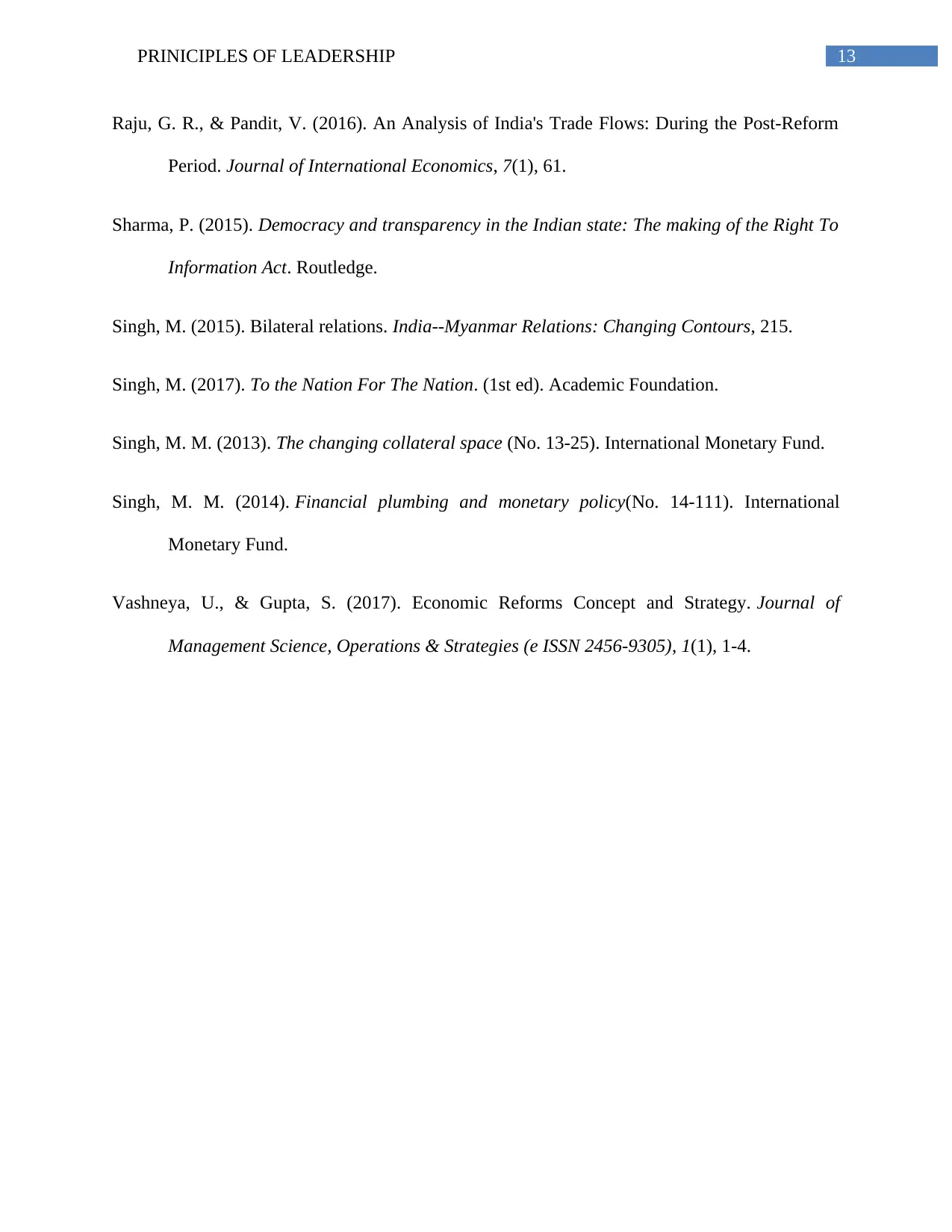
13PRINICIPLES OF LEADERSHIP
Raju, G. R., & Pandit, V. (2016). An Analysis of India's Trade Flows: During the Post-Reform
Period. Journal of International Economics, 7(1), 61.
Sharma, P. (2015). Democracy and transparency in the Indian state: The making of the Right To
Information Act. Routledge.
Singh, M. (2015). Bilateral relations. India--Myanmar Relations: Changing Contours, 215.
Singh, M. (2017). To the Nation For The Nation. (1st ed). Academic Foundation.
Singh, M. M. (2013). The changing collateral space (No. 13-25). International Monetary Fund.
Singh, M. M. (2014). Financial plumbing and monetary policy(No. 14-111). International
Monetary Fund.
Vashneya, U., & Gupta, S. (2017). Economic Reforms Concept and Strategy. Journal of
Management Science, Operations & Strategies (e ISSN 2456-9305), 1(1), 1-4.
Raju, G. R., & Pandit, V. (2016). An Analysis of India's Trade Flows: During the Post-Reform
Period. Journal of International Economics, 7(1), 61.
Sharma, P. (2015). Democracy and transparency in the Indian state: The making of the Right To
Information Act. Routledge.
Singh, M. (2015). Bilateral relations. India--Myanmar Relations: Changing Contours, 215.
Singh, M. (2017). To the Nation For The Nation. (1st ed). Academic Foundation.
Singh, M. M. (2013). The changing collateral space (No. 13-25). International Monetary Fund.
Singh, M. M. (2014). Financial plumbing and monetary policy(No. 14-111). International
Monetary Fund.
Vashneya, U., & Gupta, S. (2017). Economic Reforms Concept and Strategy. Journal of
Management Science, Operations & Strategies (e ISSN 2456-9305), 1(1), 1-4.
1 out of 14
Related Documents
Your All-in-One AI-Powered Toolkit for Academic Success.
+13062052269
info@desklib.com
Available 24*7 on WhatsApp / Email
![[object Object]](/_next/static/media/star-bottom.7253800d.svg)
Unlock your academic potential
© 2024 | Zucol Services PVT LTD | All rights reserved.





